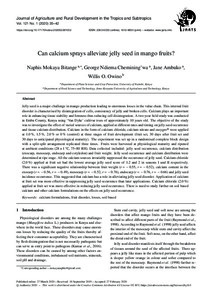| dc.date.accessioned | 2020-04-01T12:22:10Z | |
| dc.date.available | 2020-04-01T12:22:10Z | |
| dc.date.issued | 2020-03-27 | |
| dc.identifier | doi:10.17170/kobra-202002281032 | |
| dc.identifier.uri | http://hdl.handle.net/123456789/11496 | |
| dc.description | Gedruckte Ausgabe im Verlag kassel university press erschienen. | |
| dc.language.iso | eng | eng |
| dc.rights | Namensnennung - Weitergabe unter gleichen Bedingungen 4.0 International | * |
| dc.rights.uri | http://creativecommons.org/licenses/by-sa/4.0/ | * |
| dc.subject | calcium formulations | eng |
| dc.subject | fruit disorder | eng |
| dc.subject | losses | eng |
| dc.subject | soil based | eng |
| dc.subject.ddc | 630 | |
| dc.title | Can calcium sprays alleviate jelly seed in mango fruits? | eng |
| dc.type | Aufsatz | |
| dcterms.abstract | Jelly seed is a major challenge in mango production leading to enormous losses in the value chain. This internal fruit disorder is characterised by disintegration of cells, consistency of jelly and broken cells. Calcium plays an important role in enhancing tissue stability and firmness thus reducing cell disintegration. A two-year field study was conducted in Embu County, Kenya using ‘Van Dyke’ cultivar trees of approximately 10 years old. The objective of the study was to investigate the effect of varied sources of calcium, applied at different rates and timing on jelly seed occurrence and tissue calcium distribution. Calcium in the form of calcium chloride, calcium nitrate and easygro® were applied at 1.0%, 1.5%, 2.0% or 0% (control) at three stages of fruit development (fruit set, 30 days after fruit set and 30 days to anticipated physiological maturity). The experiment was set up in a randomised complete block design with a split-split arrangement replicated three times. Fruits were harvested at physiological maturity and ripened at ambient conditions (28±1̊C, 75-80 RH). Data collected included: jelly seed occurrence, calcium distribution (exocarp, mesocarp, endocarp and cotyledon) and fruit weight. Jelly seed occurrence and calcium distribution were determined at ripe stage. All the calcium sources invariably suppressed the occurrence of jelly seed. Calcium chloride (2.0%) applied at fruit set had the lowest average jelly seed score of 1.2 and 2 in seasons I and II respectively. There was a significant negative relationship between fruit weight (r = -0.55, r = -0.52), calcium content in the exocarp (r = -0.56, -0.49), mesocarp (r = -0.52,-0.76), endocarp (r= -0.76, -0.66) and jelly seed incidence occurrence. This suggested that calcium has a role in alleviating jelly seed disorder. Application of calcium at fruit set was more effective in suppressing jelly seed occurrence than later applications. Calcium chloride (2.0%) applied at fruit set was more effective in reducing jelly seed occurrence. There is need to study further on soil based calciumand other calcium formulations on the effects on jelly seed occurrence. | eng |
| dcterms.accessRights | open access | |
| dcterms.creator | Bitange, Naphis Mokaya | |
| dcterms.creator | Chemining'wa, George Ndiema | |
| dcterms.creator | Ambuko, Jane | |
| dcterms.creator | Owino, Willis Omondi | |
| dc.subject.swd | Mango | ger |
| dc.subject.swd | Ernteverlust | ger |
| dc.subject.swd | Pflanzenkrankheit | ger |
| dc.subject.swd | Calcium | ger |
| dc.type.version | publishedVersion | |
| dcterms.source.identifier | ISSN 2363-6033 | |
| dcterms.source.issue | No. 1 | |
| dcterms.source.journal | Journal of Agriculture and Rural Development in the Tropics and Subtropics (JARTS) | eng |
| dcterms.source.pageinfo | 35-42 | |
| dcterms.source.volume | Vol. 121 | |
| kup.iskup | false | |


